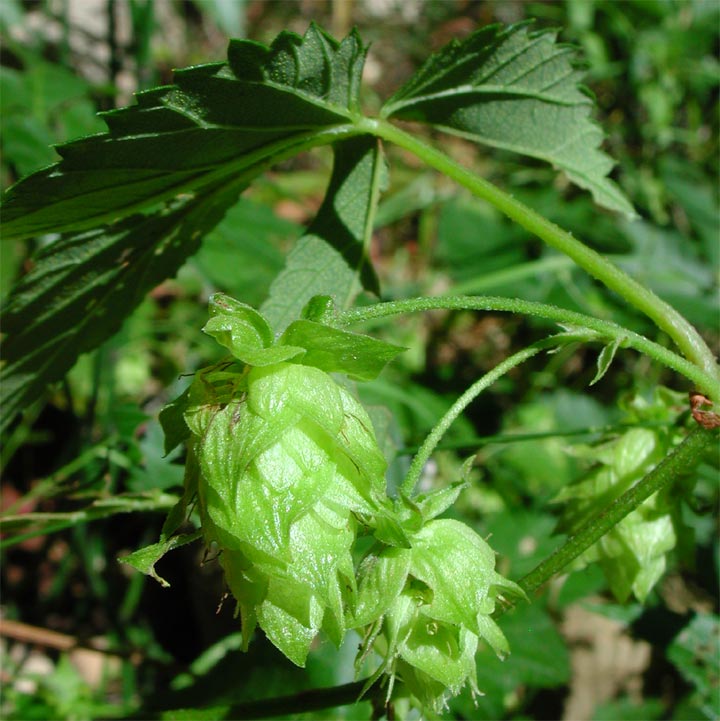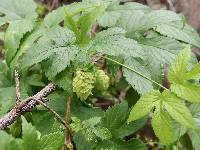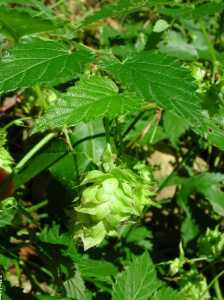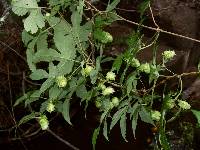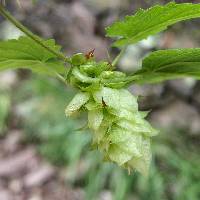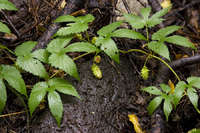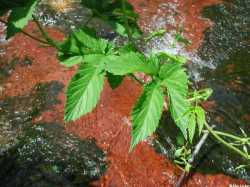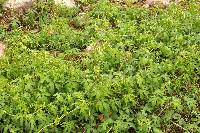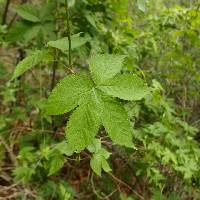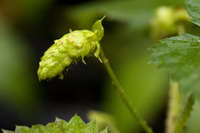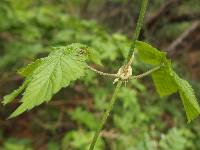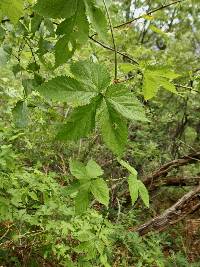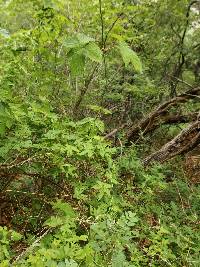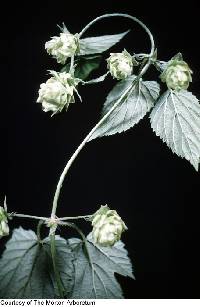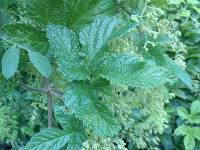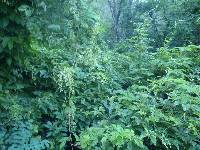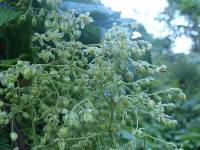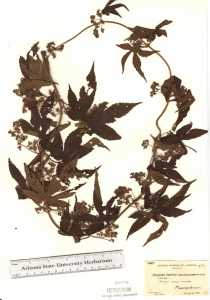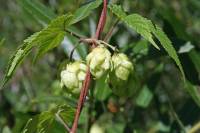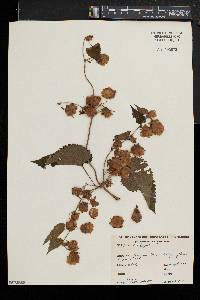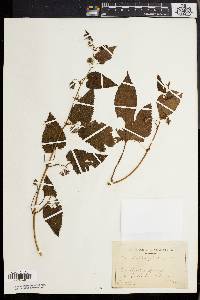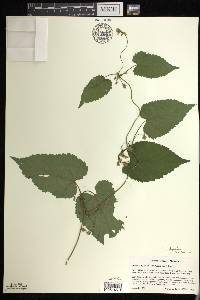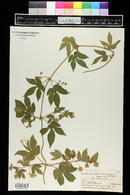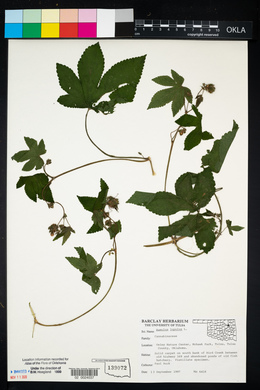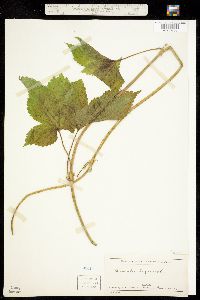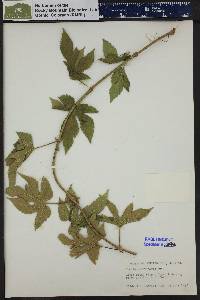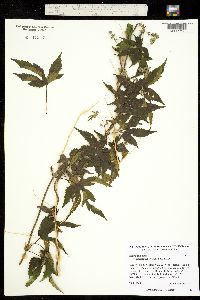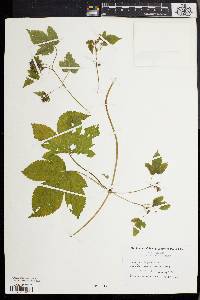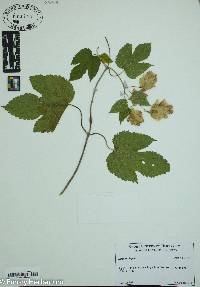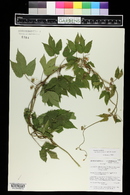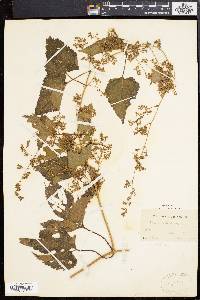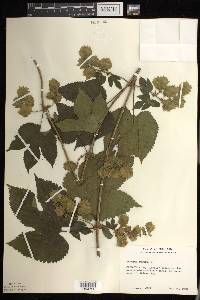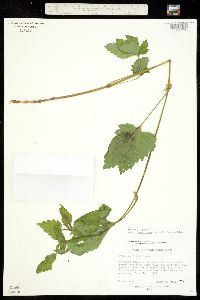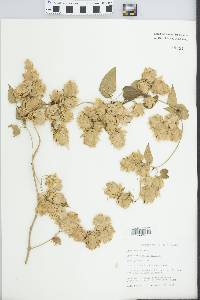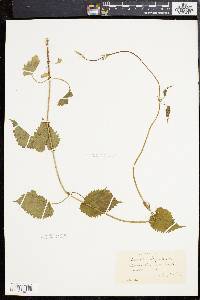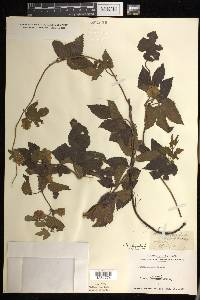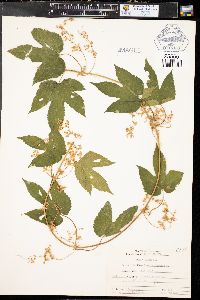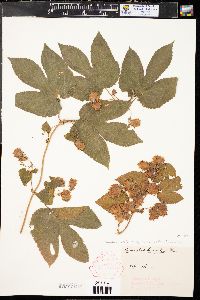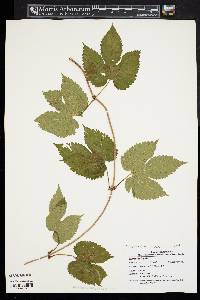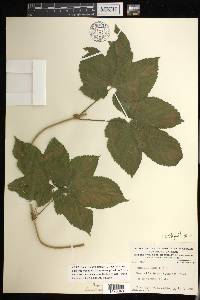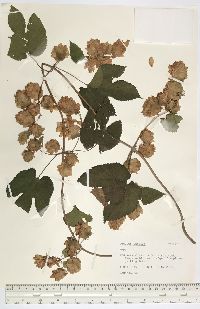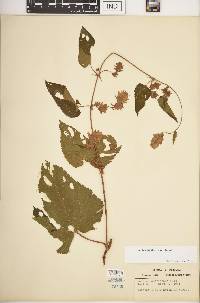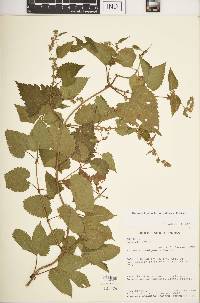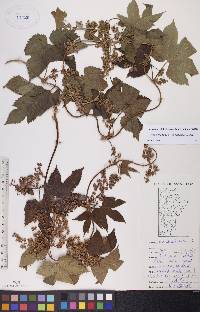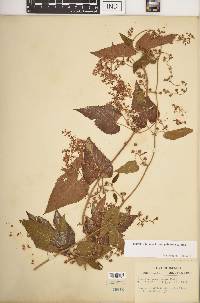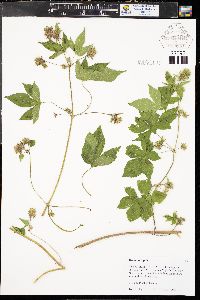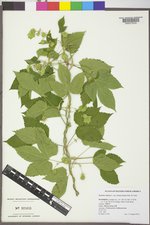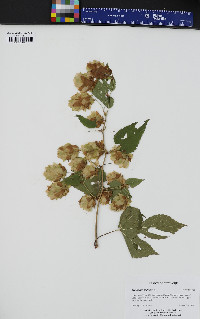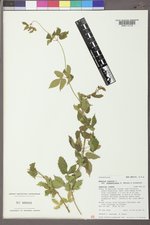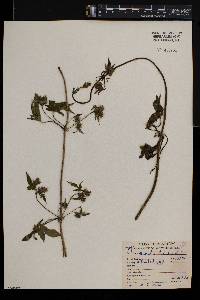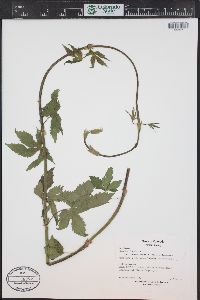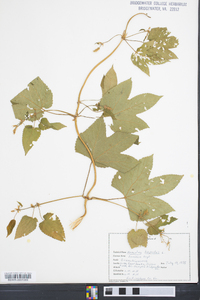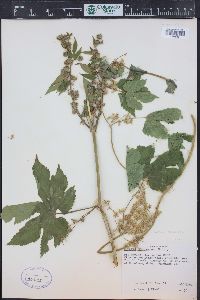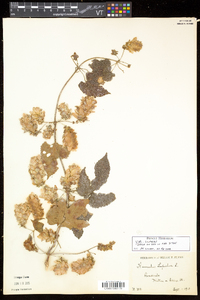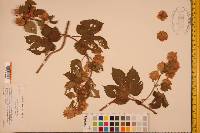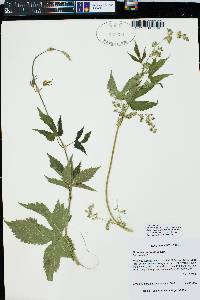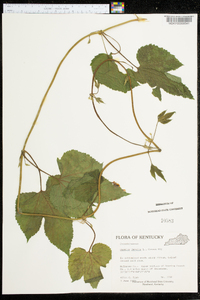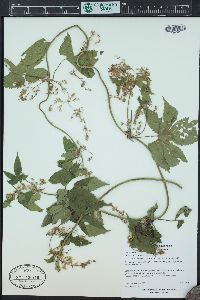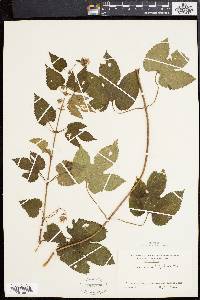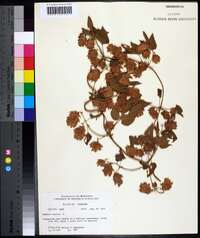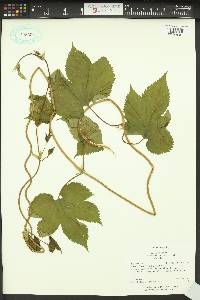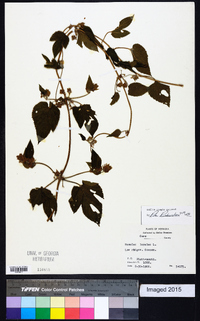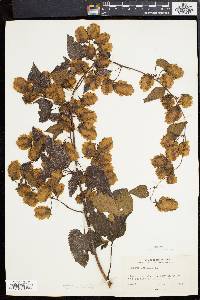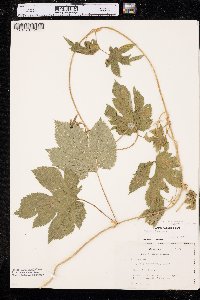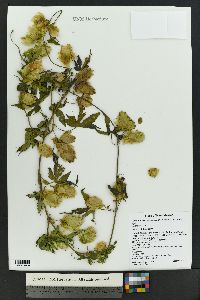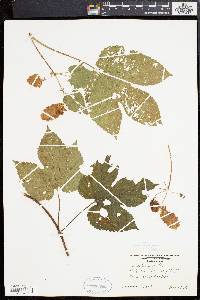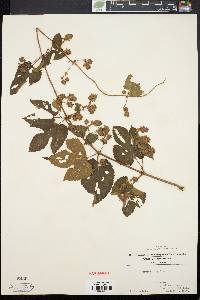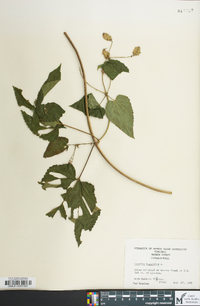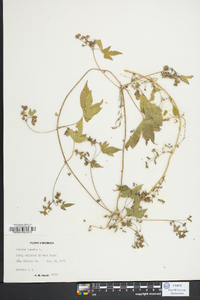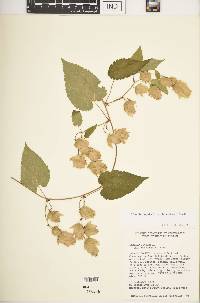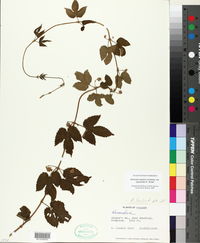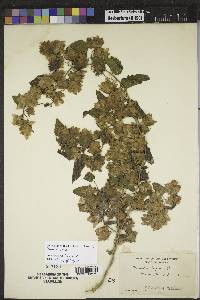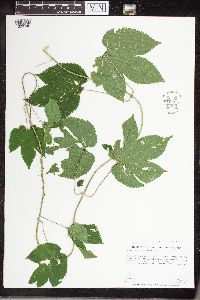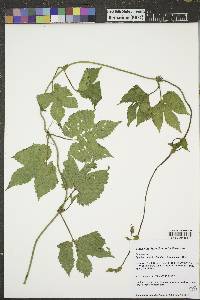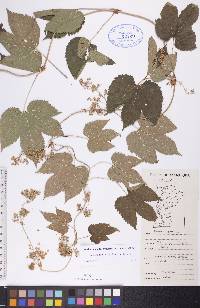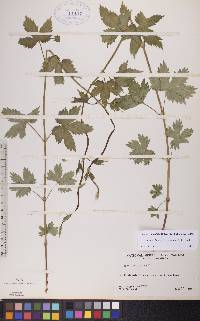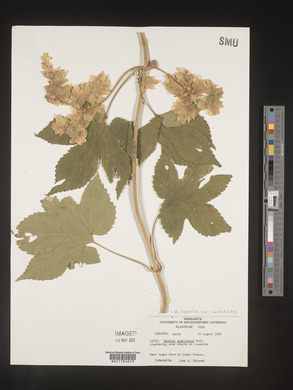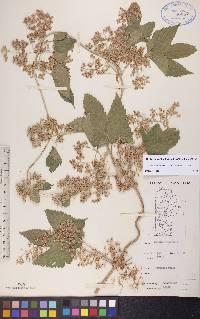
|
|
|
|
Family: Cannabaceae
Common Hop, more...hops
[Humulus aculeatus Nutt., moreHumulus yunnanensis Hu] |
Herbs , perennial, rhizomatous, 1-6(-7) m. Stems branched. Leaves: petioles usually shorter than blades. Leaf blade ± cordate, palmately 3-7-lobed, sometimes unlobed, 3-15 cm, margins dentate-serrate; surfaces abaxially with veins glabrous or with soft pubescence, without straight, erect hairs, glands yellow, adaxially margins of younger leaf blades with few or no cystolithic hairs. Inflorescences: staminate with flowers whitish to yellowish, anthers glandular; pistillate usually racemes, 10-20 mm, pedunculate; bracteole margins not ciliate-hairy. Infructescences pendulous, pale yellow, conelike, ovoid to oblong, (1-)2-3(-6) cm; bracteoles with yellow glands. Achenes yellowish, ovoid, compressed, glandular. 2 n = 20, including 2 or more sex-determining chromosomes. Until recently, knowledge of the existence of indigenous kinds of North American Humulus lupulus was uncertain, although the appellation American hop was applied sometimes to H . lupulus var. neomexicanus and sometimes confusingly to other hop varieties. The distinctive Japanese variety H . lupulus var. cordifolius (Miquel) Maximowicz has not been collected from North America. Hops cultivated commercially in North America for flavoring alcoholic beverages are forms of the European H . lupulus var. lupulus . The European variety may have been introgressed by one of the American varieties. Humulus lupulus has often been transplanted from the wild to homesites as an ornamental. When such sites are abandoned, the plants often persist, and it may appear that they are present naturally. As well, suppliers of ornamental plants may sell hops collected from one site to buyers in a quite distant site. The hop varieties discussed here may therefore be found occasionally beyond the distribution ranges given in this treatment. Native Americans used Humulus lupulus medicinally to induce sleep, for breast and womb problems, for inflamed kidneys, rheumatism, bladder problems, intestinal pain, fever, earaches, pneumonia, coughs, and nervousness, as a tonic and a stimulant, and as a witchcraft medicine (D. E. Moerman 1986). The measurements mentioned in couplet 1 of the following key are taken in the middle abaxial portion of the central lobe on 4-6 cm leaf blades attached to flowering or fruiting twigs.
Plant: herbacious vine, to 10 m or more long Leaves: ovate, unlobed or 3-5-lobed, the petiole 2.5-12 cm long, usually shorter than the blade INFLORESCENCE: staminate panicles 7-15 cm long; pistillate inflorescences 2-5 cm long at maturity, the bracts ovate to elliptic, 7-20 mm long Flowers: pistillate flowers paired, subtended by bracts and bracteoles Fruit: lenticular, enclosed by persistent perianth, ovoid compressed, 2-2.7 mm long Misc: < 3000 m. REFERENCES: Mason, Charles T., Jr. 1999. Cannabaceae. Ariz. - Nev. Acad. Sci. 32(1). Perennial herbaceous vine with rhizomes 1 - 10 m long Stem: twining, branched, with rigid, two-branched hairs that help the plant climb. Leaves: opposite, palmately three- to seven-lobed (mostly three-lobed), sometimes unlobed, 3 - 15 cm long, main leaves as wide as long, broadly egg-shaped to more or less heart-shaped with a pointed tip, toothed, sometimes softly hairy beneath, yellow-glandular. Flowers: either male or female, borne on separate plants (dioecious), small, without petals. Male flowers whitish to yellowish, with five sepals. Stamens five. Anthers glandular. Female flowers short-stalked, subtended by a leaf-like bract. Ovary covered by the membranous, fused sepals (calyx). Stigmas two, thread-like. Fruit: an achene, enclosed inside the persistent sepals, yellowish, egg-shaped, compressed, glandular, covered by bracts. Male inflorescence: an axillary and terminal, cluster (cymose panicle) of flowers, 5 - 15 cm long. Female inflorescence: an axillary spike of two flowers, 1 - 6 cm long, subtended by a leaf-like bract that is straw-colored, blunt, and glandular at the base. Similar species: The similar Humulus japonicus differs by having non-glandular, mostly five- to nine-lobed leaves. Flowering: August to mid-September Habitat and ecology: Found on floodplains and in weedy areas under partial shade. Occurence in the Chicago region: native Etymology: Humulus comes from the word humus, meaning ground, referring to the trailing habit of this plant. Lupulus means "little wolf." Author: The Morton Arboretum FNA 1997, Martin and Hutchins 1980 Duration: Perennial Nativity: Non-Native Lifeform: Vine General: Rhizomatous vine with branching stems, can grow to be 10 m or more. Leaves: With 3-7 palmate lobes with acuminate tips, venation evident, margins dentate to serrate, pubescent or glabrous. Flowers: Borne in cone-like stacks of greenish-white or light yellow scales (bracts), elongated and tapering to a pointed tip, 10-20 mm, staminate flowers whitish-yellow, with pistillate racemes. Fruits: Achenes yellow-white, ovoid, compressed, and glandular. Ecology: Found in moist thickets, woodlands and along river banks from 6,000-8,000 ft (1829-2438 m), flowers July-August. Distribution: Ranges throughout Arizona in the higher elevation woodlands and mountains, north to Canada, east to the coast and throughout the intermountain west. Notes: FNA notes this species has been widely used for ornamental use. When identifying, look for the distinctive palmate leaves and the classic hop flowers/fruit. Often in large patches in more mesic areas. Ours are often designated as being var. lupuloides. Synonyms: None Editor: LCrumbacher, 2011 Rhizomatous perennial vine to 10 m; principal lvs as broad as long, cordate at base, 3-lobed to below the middle, the upper lvs often broadly ovate and lobeless; petiole shorter than the blade; staminate infls 5-15 cm; pistillate spikes 1 cm, becoming 3-6 cm, the persistent, accrescent bracts entire and mostly blunt, stramineous, very glandular at base; 2n=20. Moist soil; N.S. to Man., Mont., and Calif., s. to N.C., Ark., and Ariz., and widely distributed in the Old World. July, Aug. 5 geographically significant vars., 3 in our range. Gleason, Henry A. & Cronquist, Arthur J. 1991. Manual of vascular plants of northeastern United States and adjacent Canada. lxxv + 910 pp. ©The New York Botanical Garden. All rights reserved. Used by permission. |
|
|
|

